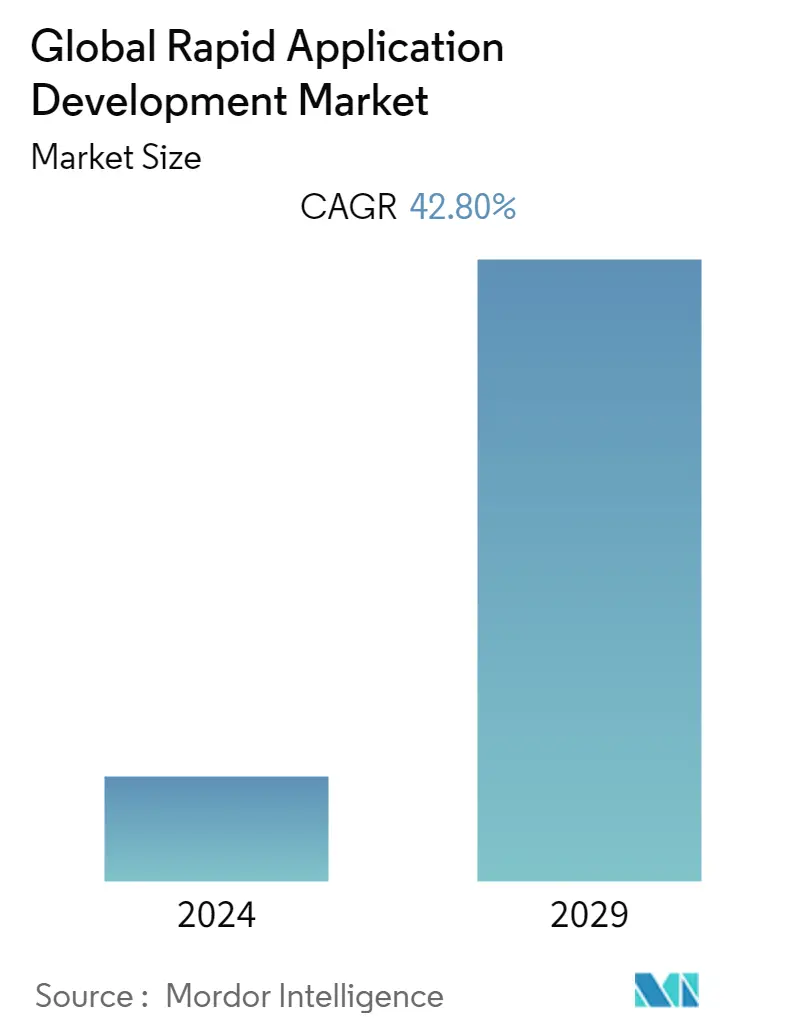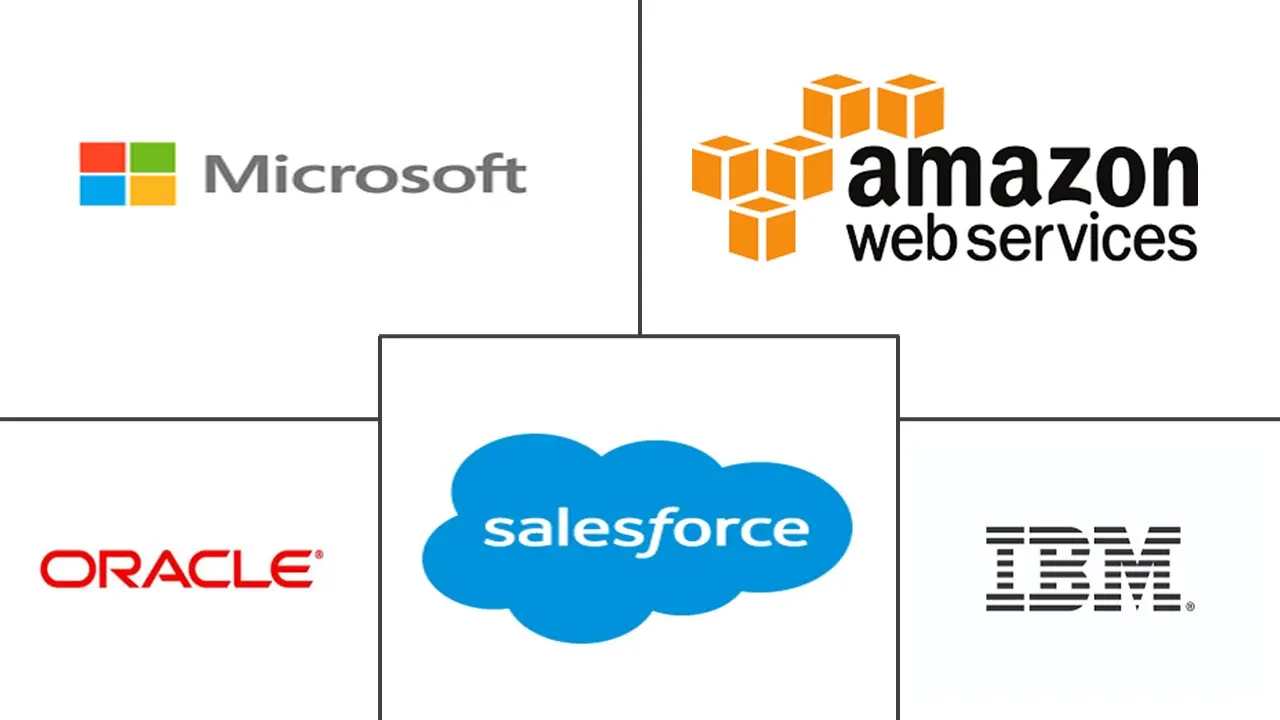Market Size of Global Rapid Application Development Industry

| Study Period | 2019 - 2029 |
| Base Year For Estimation | 2023 |
| CAGR | 42.80 % |
| Fastest Growing Market | Asia Pacific |
| Largest Market | North America |
| Market Concentration | Medium |
Major Players
*Disclaimer: Major Players sorted in no particular order |
Rapid Application Development Market Analysis
The Global Rapid Application Development Market is anticipated to reach a CAGR of 42.8% during the forecast period (2022 - 2027). The market's growth is attributed to the advantages over other development models, such as requirements that can be changed at any time, encouraging and prioritizing customer feedback, and more.
- The increasing developments, growing demand for applications integration, and rising need for microservices with robust application requirements are some of the major factors driving the studied market growth over the forecast period. Further, growing innovations across businesses and integrating advanced technologies in their business processes augment the demand for application development across industries.
- In May 2021, The software and digital engineering products company, Innominds launched its low-code platform for software development. With the market release of the platform, called iSymphony, Innominds joins the fast-growing low-code no-code movement for rapid application development (RAD). iSymphony provides a development environment to create application software through a graphical user interface and configuration instead of traditional hand-coded computer programming.
- According to DigitalOcean, 65% of founders in 2020 cite technical know-how around maintaining infrastructure as a top barrier to entry for new businesses. Handling everyday infrastructure tasks like provisioning and managing servers, operating systems, databases, application runtimes, and other dependencies, with the help of application platform solutions, enables enterprises to gain competitive advantages.
- Retail and Financial enterprises deliver the most engaging mobile application solutions with the help of rapid application development platforms. End users are adopting a range of mobile applications, from rich native mobile applications with iOS and Android device integrations to lightweight progressive web applications that don't require App Store downloads.
- RAD relies on rapid iteration and development. This requires advanced skills in the field. All parties involved must have equivalent and appropriate professional competence, and forming such a team could be difficult. Rapid application development works well with small, closely related teams. This is because this model requires effective collaboration. Further, this could be a challenge without experienced professionals in an organization.
- The COVID-19 outbreak has expanded the studied market scope, owing to the growing investment in digital applications across all industries. Industries that could have taken months and years to adopt digital and cloud technologies are now mainly relying on these for working efficiently. This is a further growing need for tools and platforms that streamline processes and eliminate time-consuming tasks. Hence, the demand for rapid application development platforms is expected to increase, as it is an application development model that places a heavy focus on speed, user strategy, and prototyping.
Rapid Application Development Industry Segmentation
Rapid Application Development (RAD) is a software development method. It focuses on developing and designing applications through rapid prototyping and feedback cycles. The model comprises four steps - defining the requirements, prototyping, receiving feedback, and finalizing software. The market is sgemented based on type that includes low-code development platforms, no-code development platform and it is further segmented based on the size of the organizations. The studied market also briefs about the COVID-19 impact on the market.
| By Type | |
| Low-Code Development Platforms | |
| No-Code Development Platforms |
| By Deployment Mode | |
| On-Premise | |
| Cloud |
| By Organization Size | |
| Small and Medium Enterprises | |
| Large Enterprises |
| By End-user Industry | |
| BFSI | |
| Retail and E-commerce | |
| Government and Defense | |
| Healthcare | |
| Information Technology | |
| Other End-user Industries (Energy and Utilities, Manufacturing, etc.) |
| By Geography | |
| North America | |
| Europe | |
| Asia-Pacific | |
| Rest of the World |
Global Rapid Application Development Market Size Summary
The Global Rapid Application Development (RAD) Market is experiencing significant growth, driven by its advantages over traditional development models, such as flexibility in requirements, emphasis on customer feedback, and rapid iteration capabilities. The increasing demand for application integration and microservices, along with the integration of advanced technologies across industries, is propelling market expansion. The COVID-19 pandemic has further accelerated this growth, as businesses rapidly adopted digital and cloud technologies to enhance efficiency. RAD platforms are particularly beneficial for small and medium-sized enterprises (SMEs), enabling them to develop customer-centric applications quickly and cost-effectively, thereby improving productivity and return on investment.
The market is moderately concentrated, with key players like Microsoft, Oracle, Salesforce, and IBM actively launching new products and technologies to maintain competitiveness. The Asia-Pacific region is witnessing substantial growth due to the adoption of advanced technologies and the expansion of cloud-based service providers. Countries such as China, India, and Singapore are leading this trend, influencing the rapid application development landscape. The introduction of low-code platforms by companies like OutSystems and Mendix in regions like India and China highlights the global shift towards faster and more efficient application development processes. These platforms are designed to reduce time to market and adapt to changing market needs, further driving the market's growth.
Global Rapid Application Development Market Size - Table of Contents
-
1. MARKET INSIGHTS
-
1.1 Market Overview
-
1.2 Industry Attractiveness - Porter's Five Forces Analysis
-
1.2.1 Bargaining Power of Suppliers
-
1.2.2 Bargaining Power of Consumers
-
1.2.3 Threat of New Entrants
-
1.2.4 Intensity of Competitive Rivalry
-
1.2.5 Threat of Substitute Products
-
-
1.3 Assessment of COVID-19 Impact on the Market
-
-
2. MARKET SEGMENTATION
-
2.1 By Type
-
2.1.1 Low-Code Development Platforms
-
2.1.2 No-Code Development Platforms
-
-
2.2 By Deployment Mode
-
2.2.1 On-Premise
-
2.2.2 Cloud
-
-
2.3 By Organization Size
-
2.3.1 Small and Medium Enterprises
-
2.3.2 Large Enterprises
-
-
2.4 By End-user Industry
-
2.4.1 BFSI
-
2.4.2 Retail and E-commerce
-
2.4.3 Government and Defense
-
2.4.4 Healthcare
-
2.4.5 Information Technology
-
2.4.6 Other End-user Industries (Energy and Utilities, Manufacturing, etc.)
-
-
2.5 By Geography
-
2.5.1 North America
-
2.5.2 Europe
-
2.5.3 Asia-Pacific
-
2.5.4 Rest of the World
-
-
Global Rapid Application Development Market Size FAQs
What is the current Global Rapid Application Development Market size?
The Global Rapid Application Development Market is projected to register a CAGR of 42.80% during the forecast period (2024-2029)
Who are the key players in Global Rapid Application Development Market?
Microsoft Corporation, Oracle Corporation, Salesforce.com Inc., IBM Corporation and Amazon Web Service are the major companies operating in the Global Rapid Application Development Market.

